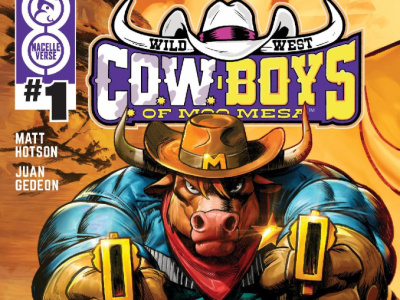Sharpening the Sword is a regular column by retailer John Riley, owner of Grasshopper's Comics, a 1300 square foot comic and game store in Williston Park, New York. This week, Riley is on the third week of a four-week series on business planning, and covers market analysis and marketing.
Here we are in week three of our Business Plan and we've come to the area that we are all prone to make the most mistakes in, Market Analysis and Marketing. This is a rather large category, but I'm going to cover it in one shot as it's very inter-related. The areas covered are:
Market Analysis
Target Market & Demographics
Competition: Direct & Indirect
Marketing Strategy
So what exactly is Market Analysis? Well, it's as subjective as each person's opinion of what's going on in our market. Is the market for each of your products growing? Do you think that it will continue to grow? Why? What's your local market like? What's happening in your town or city that could affect your business? Is your area aging or is it turning over to younger families?
The problem is we can convince ourselves of what we want to believe. Since this is so subjective and industry numbers can be manipulated in many ways, it's easy to find an argument that supports what you want to believe. But for the sake of your business you need to determine what's really happening as opposed to what you'd like to happen.
For example, look at comic books. On one end we could say that the comic book market is very healthy. Sales are relatively strong and the trend for successful comic-related movies has continued and shows no sign of abating. In many ways, awareness of comics is at a high point. Yet our sales figures as an industry speak toward a slow decline in the sales of regular comic books with growth coming in the form of trade paperbacks and other areas. So it's easy to argue that the market is strong and in decline based upon how you interpret things.
Your Target Market is also tied into this area of the plan. What is your Target Market for the Products that you identified earlier? Is there an age group or demographic that you should be targeting over others? This area of the plan is primarily to inform anyone that is unfamiliar with your business that might be reviewing the plan, but it's always good to look at who your customers really are.
OK, now the dangerous part, Competition. The two points that need to be made about your competition is that there is more of it than you realize and that every single competitor does something better than you. It's far too easy to say, 'All my competitors are horrible.' But in all honesty, every single one of them has something you don't have. Maybe they have more back issues, more statues, or more knowledge of card games. Maybe they run more tournaments, or have more room than you. Heck, maybe they just have more time to stand around and talk. Although you may not like the way they run their businesses, it's important to give them credit. For example, if you have room for twenty people to play in your store but your competitor has room for a hundred then he has an advantage in that area. You may not like the way he runs his tournaments or agree with him in any way, but he can fit more people than you can and that's that. If you're looking for financing, a reviewer will give your plan more respect for properly crediting your competitors than by dismissing them.
In your Competition section you should profile all your Direct Competition, being those stores that sell the same products that you do. In my plan I include a copy of their ads in the Yellow Pages, website shot (if any), and list their strengths and weaknesses. If they do something poorly you can choose to capitalize on it. If they do something well, you need to either improve in that area or let them have that it. Personally, I prefer to look at the strengths of my competitors rather than the weaknesses. If someone is doing something better than I am then I can choose to improve in that area and therefore improve my store.
All too often I've seen business plans that say, 'I have no competition.' Even if yours were the only comic and game store in your town, that would unfortunately not be true. In our industry anything that constitutes entertainment is our Indirect Competition and must be addressed in your plan. Bowling alleys, movie theatres, Toys R Us, Games Stop, iTunes, Everquest and a million other venues are all competing for your customer's entertainment dollar. Our biggest competitor at Grasshopper's isn't another comics or gaming shop but rather World of Warcraft and Star Wars Galaxies. It's hard to entertain customers when they refuse to leave their rooms for months on end! Your job in this plan is to determine how you will convince your customers that comics and/or games is actually their best entertainment choice.
Indirect Competition is so important that I plan on devoting a full article to it soon. In our industry we are being bombarded by all sides as the digital entertainment world around us explodes. How many of your customers collect DVD's? How many play online games? How many own iPods? The digital revolution is working hard to bring entertainment to your customers. First you had to schedule your TV viewing around their schedule. Then TiVo allowed you to watch when you wanted. Now the video iPod lets you take the shows with you wherever you'd like. Each progression put the entertainment media more directly in your customers' hands. So how do you get customers to leave this endless wave of entertainment to come experience what you have to offer?
Well, that's where the Marketing Strategy section comes into play. You can get a Doctorate in Business Marketing, so I can't even begin to cover it here in just a few paragraphs. Basically, what Marketing boils down to for us is how do we communicate to our customers and potential customers that they should participate in our hobby.
I suggest that you pick up a book by Jay Conrad Levinson who writes the Guerrilla Marketing series of books. These are basically written for small businesses that have to get their messages across without spending much money, and they'll give you lots of ideas for tools you can use. Go through a bunch of these books and you're sure to get a tremendous number of ideas to work with. Combine them with the decisions you made in your Products and Services section and you're now in a position to create a focused plan to promote your business, or areas of your business, based upon what products are most important to your long term health.
Some areas that I think you should address include: How will your store layout and design help to 'sell' your store to the general public? How will you use displays/signage? What services, ads, promotions, events, informative materials, will you use to promote comics or the comic art form? To promote gaming? How will you use technology to promote your store/comics/gaming? How will you use your inventory and selection to increase sales? How will you advertise and why? What services can you provide that will differentiate you from your competition?
Here at Grasshopper's, our plan for 2006 is focused on two key features: Making our store extremely attractive and exciting to people who know nothing about our hobby, and providing extensive services and events for those people who already participate. Obviously we've broken it down into pages of details, but that was our initial focus from which to work.
Once you get started it's easy to come up with pages of ideas for things you can do to improve and promote your business. But unfortunately you only have so much time, energy and money, so again ask yourself if you can only concentrate on one thing this year, what would be the one thing that would have the biggest impact on your business? That's probably a good place to start.
Wow, we're through the main sections of the Business Plan. Next time we'll briefly go over Management and Financials and wrap this whole thing up!







